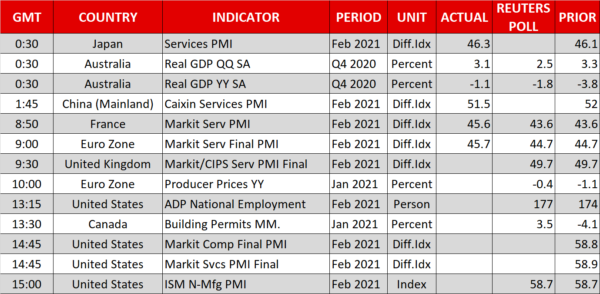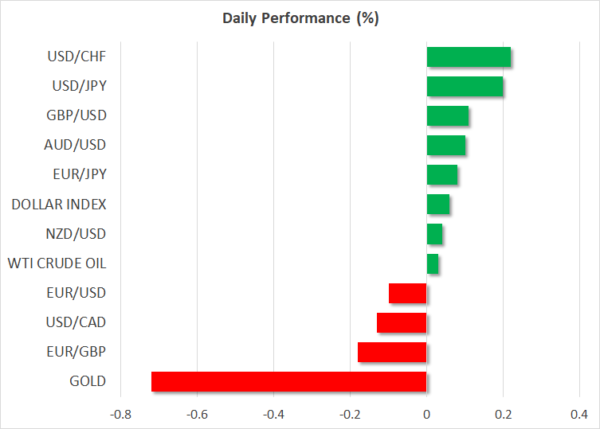- Dollar suffers sharp pullback as yields settle lower, Fed hints at unease about surge
- Economic optimism, bond market calm drive stocks, US futures higher
- Pound hoping for budget boost as $1.40 becomes elusive, euro tests $1.21
Bond market rout eases further, with a little help from the Fed
The panic that roiled bond markets last week continued to recede on Wednesday as central bankers from Europe, Australia and elsewhere warned against sudden spikes in bond yields, which have had a rippling effect in equity and currency markets. Up until yesterday, one notable absence in this pushback had been from the US Federal Reserve, with Chair Powell playing down the significance of the gyrations in Treasury yields.
However, Fed Governor Lael Brainard may have just hinted that US policymakers are not as relaxed about this spout of volatility as they’ve been indicating. In virtual remarks before the Council on Foreign Relations on Tuesday, Brainard said she would be “concerned” from any disorderly tightening in financial conditions that would “slow progress toward our goal”.
Her comments were the first from a Fed official to suggest that the central bank would not be too happy to let long-term borrowing costs rise too quickly. Meanwhile, San Francisco Fed President Mary Daly stressed that the Fed would need “a big dose of patience in the summer” to sit out any temporary rises in inflation.
Their views may have set the stage for Powell’s next big speech on Thursday when he will be attending an online event by the Wall Street Journal. The 10-year Treasury yield was last creeping above 1.43% but well within this week’s range, having earlier slipped below 1.40%.
Global stocks shrug off Wall Street’s dip
As the Fed figures out a way to sound alarmed without being too panicky, other central banks have already jumped in with verbal interventions. ECB Executive Board Member Fabio Panetta yesterday added to the chorus of displeasure from European policymakers toward the surge in yields, saying the steepening in the yield curve “must be resisted”.
The reassurance from major central banks that not only are they not about to pull the plug on the massive stimulus flooding the markets but could increase their bond purchases is buoying equities, with stocks in Asia and Europe rallying today. US stock futures are also pointing to a strong open on Wall Street following a disappointing performance yesterday when all three indices closed lower.
Aside from the steadying in bond yields, expectations that the US Senate is inching closer to finalizing President Biden’s $1.9 trillion stimulus plan is also supporting sentiment amid signs that the Democrats have the 50 votes they need to pass the bill.
Pound and euro eye key levels as dollar fights back
Amidst the somewhat more cheerful mood, the safe-haven yen and franc underperformed on Wednesday, slipping against their major peers. However, the US dollar was resisting steeper declines, having already tumbled yesterday from a near one-month top. The greenback was eyeing fresh 6-month highs versus the yen as the 107 level moves within sight, while the euro was struggling to make a decisive break above $1.21.
An upward revision to the Eurozone’s flash February PMIs is supporting the euro’s fresh push to reclaim this key level.
The Australian dollar, along with its kiwi and loonie cousins, was also seeking to extend its rebound, advancing towards $0.7840. Better-than-expected Q4 GDP growth figures out of Australia today are helping the aussie recoup some of last week’s sharp losses.
But it was the pound that was in the lead today, as the British currency was desperately trying to climb back above $1.40, having been knocked off its perch from the bond market episode. Sterling is being bolstered by expectations that the UK’s finance minister, Rishi Sunak, will unveil a growth-focused budget later today, aimed at reviving the virus-battered British economy. However, should Sunak’s spending plans not go far enough and the budget includes some stealth taxes, the pound could be in for another setback.













